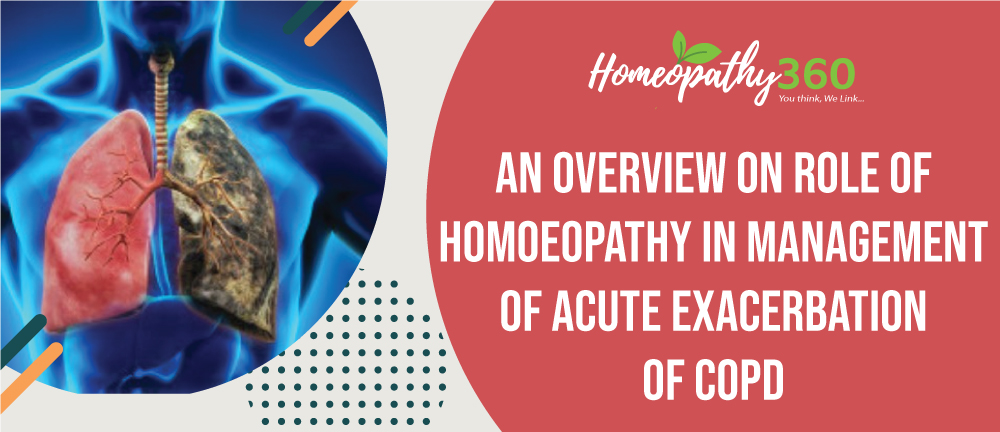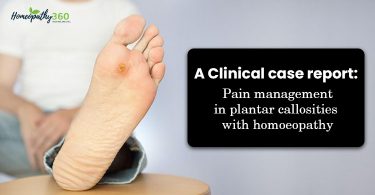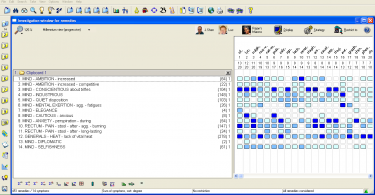
ABSTRACT: The term COPD comprises a group of clinical syndromes presenting with limited expiratory airflow. It is mainly described in terms of chronic bronchitis and emphysema. The condition characterised by persistent cough, sputum production, exertional dyspnea, has a course of asymptomatic period, followed by acute exacerbation and deterioration. The smoking and environmental pollution plays an important role in development of COPD. The acute exacerbation of COPD requires outpatient or inpatient care as per the severity of the condition. The episodes of acute exacerbation of COPD contributes to reduced quality of life and disease burden of the society. In this scenario, the homoeopathic system of medicine can lend a helping hand based on the principle of similia.
KEYWORDS: COPD, acute exacerbation, homoeopathic remedies, quality of life.
ABBREVIATIONS: chronic obstructive pulmonary disease (COPD)
INTRODUCTION
The term chronic obstructive pulmonary disease (COPD) comprises of a group of clinical syndromes that shares a common factor of limitation in expiratory flow. The American Thoracic Society describes COPD in terms of emphysema and chronic bronchitis. The chronic bronchitis is characterised by excessive cough and sputum production, whereas emphysema manifests with chronic dyspnoea resulting from enlarged air spaces and disruption of lung tissue.
COPD is characterised by persistent airflow limitation that is usually progressive and is caused by an enhanced chronic inflammatory response in the airways and lung tissue to noxious particles and gases 1.
COPD exacerbation is an event in the natural course of disease that is characterised by a change in patient’s baseline dyspnoea, cough and sputum that is beyond the normal day to day variation, and is acute in onset and warrant a change in medication. Exacerbations of COPD can be associated with both respiratory (for example, dyspnoea and productive cough) and non-respiratory (for example, fatigue and malaise) symptoms2.
The COPD remains a major cause of morbidity and mortality all over the world, and the acute exacerbations of COPD contribute a substantial burden to the health care system and hospital admissions.
It is estimated that exacerbations of COPD result in ∼110,000 deaths and more than 500,000 hospitalisations per year, with over $18 billion spent in direct costs annually3.
ETIOLOGY AND RISK FACTORS OF EXACERBATIONS OF COPD:
Risk factors for COPD are also risk factors for exacerbation of COPD. It is estimated that 70–80% of COPD exacerbations are triggered by viral or bacterial respiratory infections. The remaining 20–30% are associated with exposure to environmental pollution or have an unknown ethology1. Tobacco smoking, indoor air pollution, occupational exposure to chemical agents and inorganic dusts, outdoor pollution and genetic factors contribute to the risk of development of COPD along with abnormalities in lung development, and socioeconomic status.
COPD exacerbations may be mimicked by other medical conditions. When a patient present with dyspnoea, other co-morbidities also have to be assessed such as congestive heart failure, and pneumonia.
CLINICAL COURSE
While COPD is a mainly chronic disease, a substantial number of patients suffer from exacerbations4. Severe exacerbations are related to a significantly worse survival outcome. Commonly reported symptoms are worsening breathlessness, cough, increased sputum production and change in sputum colour. Also, they may present with tachycardia, chest tightness, and decreased exercise tolerance. The change in these symptoms often necessitates a change in medication.
MANAGEMENT:
Beside smoking cessation and medications, patients should be especially encouraged to increase their physical activity5. Oxygen therapy is of beneficial value in acute COPD exacerbation as patients are often hypoxemic2.
Reducing the number of exacerbations that a patient experiences would have a beneficial impact on their daily life, disease outcomes, and prognosis.
ROLE OF HOMOEOPATHY
Coinciding with the name acute exacerbation of COPD, is the causation in context of Homoeopathic management, i.e., exciting cause in aphorism 5 of Organon of Medicine, as very rightly mentioned by Dr Samuel Hahnemann.6
Exciting causes in regards to COPD can be listed as:
- Accidental exposure to strong chemical fumes or smoke.
- Any acute respiratory infection as a result of suppression of sweat on exposure to a cold environment.
- Poor hygiene.
- Poor diet and regimen.
- Any mental/ emotional trigger.
Also its worth quoting how Dr Hahnemann mentioned the management in an acute state of disease, by not going for deeper antipsorics, but to consider the acute symptom totality and manage with a corresponding acute remedy and once the flared up state is managed and the psora is pushed back to its latent state, we can continue with the chronic treatment (aphorism 221).6
The homoeopathic system of medicine not only treats the diseases condition but the underlying cause and the individual susceptibility. The remedies chose based on the symptom similarity will help to control the acute exacerbations as well as to reduce the intensity and frequency of the episodes. The character of cough, expectoration, dyspnea, the aggravating and ameliorating factors, the precipitating causes, and concomitants along with the physical constitution and mental makeup of the patient will help in arriving at the simillimum. The potency selection and repetition is done as per the requirement of the case.
Following are some of the remedies that can be used in management of acute exacerbations of COPD:
- Ammoniacum gummi: A remedy for aged feeble especially in chronic bronchitis, difficult breathing, large accumulation of purulent matter in the chest and feeble expectoration, worse cold weather. Coarse rattling in chest.
- Antimonium arsenicosum: Useful in emphysema with excessive dyspnoea and cough much mucous secretion, worse on eating and lying down.
- Antimonium tartaricum: Rattling of mucus with little expectoration. Much drowsiness and debility. Emphysema of the aged, bronchial tubes overloaded with mucus, dizziness with cough. Dyspnoea relieved by eructation. Cough and dyspnoea better on lying right side.
- Aspidosperma: The digitalis of the lungs according to Hale. Removes temporary obstruction to the oxidation of the blood by stimulating respiratory centers, increasing oxidation and excretion of carbonic acid. Uraemic dyspnoea. An effective remedy in many cases of asthma. It stimulates the respiratory centers and increases the oxygen in the blood. “Want of breath” during exertion is the guiding symptom. Cardiac asthma.
- Balsamum peruvianum: Useful in bronchial catarrh, bronchitis with mucopurulent, thick, creamy discharge.
- Blatta orientalis: A remedy for asthma. Especially when associated with bronchitis. Indicated after arsenic when this is insufficient. Cough with dyspnoea in bronchitis and phthisis.
- Bryonia alba: Cough dry at night, worse after eating and drinking. Coming into warm room excites cough, cough with feeling as if chest would fly into pieces.
- Calcarea carbonicum: Tickling cough troublesome at night, dry and free expectoration in morning. Extreme dyspnea. Expectoration only during the day; thick, yellow, sour mucus. Suffocating spells; tightness, burning and soreness in chest; worse going upstairs or slightest ascent, must sit down. Sharp pains in chest from before backwards. Chest very sensitive to touch, percussion, or pressure. Longing for fresh air. Scanty, salty expectoration
- Eucalyptus globulus: Asthma, with great dyspnoea and palpitation. Moist asthma. Expectoration white, thick mucus. Bronchitis in the aged. Bronchorrhoea. Profuse expectoration of offensive muco-pus. Irritative cough. Fetid form of bronchitis, bronchial dilatation and emphysema.
- Grindelia robusta: Asthmatic conditions, and chronic bronchitis, bronchorrhoea with tough mucus, difficult to detach, smothering after falling asleep. An efficacious remedy for wheezing and oppression in bronchitic patients. Sibilant rales, tough whitish mucous expectoration, cannot breathe when lying down. Asthma and emphysema with dilated heart.
- Lobelia inflata: Dyspnoea with constriction of chest, worse exertion. Better by rapid walking. Senile emphysema worse tobacco, afternoon, motion, and cold.
- Phosphorus: Cough from tickling in throat; worse, cold air, reading, laughing, talking, from going from warm room into cold air. Sweetish taste while coughing. Hard, dry, tight, racking cough. Congestion of lungs. Burning pains, heat and oppression of chest. Tightness across chest; great weight on chest. Sharp stitches in chest; respiration quickened, oppressed. Much heat in chest. Pneumonia, with oppression; worse, lying on left side. Whole body trembles, with cough. Sputa rusty, blood-colored, or purulent.
- Rumex crispus: Dry, teasing cough, preventing sleep. Aggravated by pressure, talking, especially by inspiring cool air and at night. Thin, watery, frothy expectoration by the mouthful: later, stringy and tough. Rawness of larynx and trachea. Soreness behind sternum, especially left side, in region of left shoulder.
- Senega: Bronchial catarrh with sore chest walls, rattling in chest, cough ends in a sneeze, chest oppressed on ascending, asthenic bronchitis of old people with chronic emphysema.
- Spongia tosta: Respiration short, panting, difficult; feeling of a plug in larynx. Cough abates after eating or drinking, especially warm drinks. The dry, chronic sympathetic cough or organic heart disease is relieved by Spongia tosta. Irrepressible cough from a spot deep in chest, as if raw and sore. Bronchial catarrh, with wheezing, asthmatic cough, worse cold air, with profuse expectoration and suffocation; worse, lying with head low and in hot room.7
CONCLUSION:
Exacerbations of COPD have a substantial impact on health status and cumulative effects on lung function. Many exacerbations are unreported, which may also lead to under-treatment and poorer recovery. Thus, the timely identification and prompt management is important in helping the patient to road of recovery. The homoeopathic remedies selected based on symptom similarities will surely help them to travel the path of recovery.
REFERENCES
- Qureshi, H., Sharafkhaneh, A., & Hanania, N. A. (2014). Chronic obstructive pulmonary disease exacerbations: latest evidence and clinical implications. Therapeutic advances in chronic disease, 5(5), 212–227. https://doi.org/10.1177/2040622314532862
- Pavord, I. D., Jones, P. W., Burgel, P. R., & Rabe, K. F. (2016). Exacerbations of COPD. International journal of chronic obstructive pulmonary disease, 11 Spec Iss(Spec Iss), 21–30. https://doi.org/10.2147/COPD.S85978
- Impact of exacerbations on COPD, A. Anzueto, European Respiratory Review 2010 19: 113-118; DOI: 10.1183/09059180.00002610
- Exacerbations of COPD, Christian Viniol, Claus F. Vogelmeier, European Respiratory Review 2018 27: 170103; DOI: 10.1183/16000617.0103-2017
- Crisafulli, E., Barbeta, E., Ielpo, A. et al. Management of severe acute exacerbations of COPD: an updated narrative review. Multidiscip Respir Med 13, 36 (2018). https://doi.org/10.1186/s40248-018-0149-0
- Hahnemann S. Organon of Medicine. B Jain Publishers. 5th Edition, 2002. India. p 31,32,114
- Boericke W. Pocket Manual of Homoeopathic Materia Medica and Repertory. B Jain Publishers.9thEdition,2012, India. p 39,55,58,94,103,123,132,144,270,313,405,507,558,584,603.
About the authors
- Dr Raisa Cheriyan, BHMS, MD (Hom.). Assistant Professor, Department of Obstetrics and Gynaecology, Father Muller Homoeopathic Medical College, Mangaluru.
- Dr Sherlyn Elizabeth Paul, BHMS, MD (Hom). Assistant Professor, Department of Homoeopathic Materia Medica, Father Muller Homoeopathic Medical College, Manguluru.





